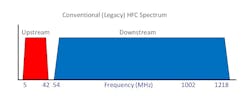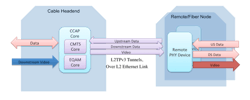Truth is, there is no 5G (generation) without 10G (gigabytes), and if we are to keep up with customer demands, it’s time to upgrade our plants -- again.
The following explains where we’ve been, why we need upgrading and what in blue blazes DOCSIS 4.0 is – and why it’s needed for achieving 10G.
Need to upgrade
Speed on consumer data networks has been increasing at approximately 50% per year since modems were introduced (see http://grouper.ieee.org/groups/802/3/ad_hoc/bwa/public/apr12/Comment_25_0412.pdf). Customer demands for faster networks are driven by newer, higher-bandwidth applications. VOIP necessitated DOCSIS 2.0 technology. Streaming video and HD drove DOCSIS 3.0 and 3.1. Now, HD is upconverting to 4K and beyond.
One option for operators needing to increase network capacity is to use “node splitting” to reduce service group size.
Many nodes have been split already, so further plant segmentation must happen at another location, like existing amplifiers, which would be converted into new nodes.
Replacing amplifiers with nodes is the basis for cascade reduction, where a plant previously at Node + 5, for example, is changed to Node + 3. It is also the basis for “Fiber Deep,” or Node + 0, where fiber nodes replace all amplifiers.
By running a higher order of modulation on QAM carriers transmitting DOCSIS (and other) signals, a bandwidth’s throughput may be increased. This is only possible if the signal-to-noise ratio can support higher order modulation at an acceptable error rate. Fortunately, when the cascade of amplifiers is reduced, the signal-to-noise improves. Further, when transmission changes from traditional analog laser/receiver nodes to a Distributed Access Architecture (DAA), it improves further. The combination of these with advanced DOCSIS 3.1 error correction capabilities makes 16384QAM downstream possible, yielding a 40% improvement over today’s 1024QAM.
The greatest bandwidth increase comes from expanding a network’s RF spectrum. As with traditional upgrades, the highest RF frequency is extended by replacing elements within the coaxial network. DOCSIS 4.0 is the latest CableLabs specification to address the full possibilities of HFC.
What is DOCSIS 4.0?
DOCSIS 4.0 (CableLabs Physical Layer Specification - CM-SP-PHYv4.0-I01-190815) consolidates portions of DOCSIS 3.1 into one new specification and expands it to include greater plant RF bandwidth.
1.2 GHz is the top frequency DOCSIS 3.1 specifies. Most operators use this with a “sub-split” or “low-split” 5- to 42-MHz upstream frequency range and downstream from 54-1200 MHz (Figure 1). This creates a lopsided transmission capability limiting upstream speeds to below 300 Mbps. To improve this, DOCSIS 4.0 expands the downstream RF frequency range by extending spectrum and implementing Full Duplex DOCSIS (FDX).
What infrastructure changes does DOCSIS 4.0 require?
Fiber Plant Changes
Architecture changes (DAA, Remote-Phy)
Switching from an analog HFC architecture to a DAA (Figure 4) does not, in itself, require network topology changes. However, when this transition is coupled with other changes, like node splitting, bandwidth changes or cascade reduction, the fiber plant will need re-work.
Amplifier cascade reduction (Node + X)
Cascade reductions require fiber extensions that can connect service groups to new nodes. If the plant has enough spare fibers available, new cable from an existing fiber plant splice is installed. If spare fibers are few, the only alternative to extensive construction is installing CWDM or DWDM.
Wavelength considerations
Unfortunately for CWDM, fiber attenuation changes as you depart from 1550 nm, and there are a limited number of wavelengths available in CWDM systems. Therefore, DWDM is preferred.
Changes to the RF (Coaxial) Plant
Changes to the coaxial plant in a DOCSIS 4.0 revolve around supporting ESD and FDX.
For supporting ESD, the bandwidth capability of all coaxial network components must be evaluated. For example, let’s consider expansion to 1.8 GHz.
Nodes
Nodes must be capable of operating up to 1.8 GHz. If the upstream/downstream split is to be changed, the nodes must also be able to accommodate new diplex filters and upstream transmitters.
Amplifiers
Unless also converting to Node + 0, the amplifiers will need to be able to pass the new 1.8-GHz downstream spectrum and new diplex filters.
Taps
Many of today’s taps will perform beyond 1.2 GHz without further upgrades. However, few will go beyond 1.5 GHz. Taps will need to be replaced. This might be limited to a plate change, which is less disruptive than entire tap housing alterations. A review of tap specifications and possible lab testing is needed before considering such an upgrade.
Coax cable (hardline and drop)
Most modern hardline coaxial cable can operate to 1.8 GHz and beyond. However, attenuation at these higher frequencies presents design challenges. An outside plant cable specified at 1.94 dB/100 ft at 1.2 GHz would instead lose 2.43 dB/100 ft at 1.8 GHz. That same cable would lose over 3 dB/100 ft at 3 GHz.
Drop cable and in-home cable are of greater concern. A common RG-6 drop measuring 7.2 dB/100 ft at 1.2 GHz clocks in at 8.97 dB/100 ft at 1.8 GHz and nearly 12 dB/100 ft at 3 GHz. Even larger RG-11 cable loses 8 dB/100 ft at 3 GHz. This could cause dramatic in-home signal level reductions.
The top frequency of connectors in the network should also be reviewed. Several manufacturers show new connectors specified to 3 GHz today.
CPE
Any DOCSIS 3.1 modem has a top frequency of 1218 MHz and would not benefit from ESD. Legacy TV set-top boxes, TV tuners and other devices are also not specified to work above 1218 MHz, and some might be further limited. To capitalize on new plant capabilities, much of the CPE would need to be replaced with DOCSIS 4.0 specified equipment.
If operated using OFDM signals, devices could work at lower downstream RF levels than they do today. This is important because the new higher frequencies will likely arrive at lower levels due to higher drop attenuation.
Drop/home architecture
Converting from a plant-extension architecture to a gateway architecture can help manage lower signal levels in customers’ homes. In a plant-extension architecture, the entire RF spectrum is split to feed all in-home devices. The loss of splitters and internal coaxial cable wiring applies to every network device. When operating at higher frequencies than we use today, there might not be enough level to support conventional QAM signals. OFDM would fare better but would still be challenging.
In a gateway architecture, plant signals are terminated at a single device. The in-home coaxial network, if used, is completely isolated behind the gateway. Signal level to the gateway is the only challenge but is not hampered by splitters and internal coaxial wiring. The gateway device acts as a high-speed data services router and access point and connects to customer devices via WiFi and Ethernet. For TV, it connects via Ethernet, MoCA or WiFi to “mini” set-top boxes.
If the spectrum is expanded, FDX brings the same challenges as ESD. However, FDX also brings its own new challenges.
FDX requires Node + 0 architecture support. With current technology, echo cancelation will not function if an amplifier is in the line. Proposed workarounds might permit Node + 1 but require replacing amplifiers, at a minimum.
Because new FDX modems will transmit on frequencies within the passband of legacy devices, like set-top boxes, in-home interference is problematic. A cable modem’s high-level RF could pass from port to port on an in-home splitter and be detected in the set-top box, causing video “hits” whenever it transmits.
The problem could be worse. In some instances, the signal from one home could pass from one tap port to another and interfere with a different home’s legacy equipment.
Installing filters on the FDX frequency band in front of legacy devices could combat this. Alternatively, one could convert to a gateway architecture.
Can DOCSIS 4.0 components be used individually?
Given the potential costs and disruptions that full-on DOCSIS 4.0 deployments bring, operators should explore how its pieces might be used individually. Some operators are avoiding Node + 0 and not reducing service group size. Examination of congestion levels and predicted speed needs could show that higher QAM modulation levels available with a DAA deployment followed by a short cascade of amplifiers would deliver the required speed increase.
While choosing to avoid Node + 0 would rule out FDX, ESD is still viable. If amplifiers are changed to allow the upstream/downstream split to shift, up to 1-Gbps symmetrical service is possible. To achieve cascade reduction or change to a Node + 0 architecture, additional fiber or wavelengths will be required on the existing fiber plant to feed them.
It’s Time to Buckle Up!
Our industry meets disruption head on! The bandwidth storm is here. And again, we are ready with incredible capabilities, like the DOCSIS 4.0 HFC toolkit or the unbeatable fiber-to-the-home cure-all.
While DOCSIS 4.0 presents formidable challenges, its deployment is far from impossible. And operators have shown, time and again, they are up to the task.
Dave Kozischek is market manager, enterprise networks at Corning Optical Communications. In this role, he is responsible for creating and leading efforts to drive optical solutions in targeted MSO/CATV FTTx application areas. FTTx may include FTTH, FTTB, FTTC, FTTT or other fiber deep architectures deployed by the MSO/CATV market. Kozischek is also responsible for providing deep FTTx application/market expertise and thought leadership externally, and providing marketing leadership for new product commercializations
Jack Burton is a principal at Broadband Success Partners.










